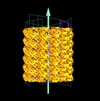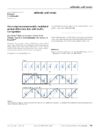issue contents
August 2011 issue

Cover illustration: Pictorial one-dimensional helical symmetry description of three helical structures determined by X-ray fibre diffraction (p. 716). The three depicted helical structures are the filamentous bacteriophage ph75 (PDB entry 1hgv), F-actin (PDB entry 2zwh) and the cucumber green mottle mosaic virus (PDB entry 1cgm). Individual asymmetric subunits are each represented by a color isosurface entity and each color represents a helix specified by the helical symmetry.
research papers
The crystal structure of 5-hydroxyisourate hydrolase from K. pneumoniae and the steady-state kinetic parameters of the native enzyme as well as several mutants provide insights into the catalytic mechanism of this enzyme and the possible roles of the active-site residues.
PDB reference: 5-hydroxyisourate hydrolase, 3qva
The crystal structure of 2-oxo-3-deoxygalactonate kinase from the De Ley–Doudoroff pathway of galactose metabolism has been determined at 2.1 Å resolution.
PDB reference: 2-oxo-3-deoxygalactonate kinase, 3r1x
This study presents the crystal structure of catalase from the thermotolerant yeast H. polymorpha at 2.9 Å resolution.
PDB reference: peroxisomal catalase, 2xq1
A script was created to allow SHELXL to use the new CDL v.1.2 stereochemical library which defines the target values for main-chain bond lengths and angles as a function of the residue's φ/ψ angles. Test refinements using this script show that the refinement behavior of structures at resolutions even better than 1 Å is substantially enhanced by the use of the new conformation-dependent ideal geometry paradigm.
Purine biosynthesis is considered to be a promising new antibiotic target; in this article, the structural and biochemical characterization of S. aureus PurK and PurE are described.
Open  access
access
 access
accessA new representation of helical structure by four parameters, [n1, n2, twist, rise], is able to generate an entire helical construct from asymmetric units, including cases of helical assembly with a seam.
The performance of molecular-replacement approaches can be enhanced by utilizing anomalous differences and substructure information.
short communications
Application of a highly detailed model for the bulk solvent obtained from molecular-dynamics simulations shows an improvement of the totally cross-validated free R value of only 0.3%.
An anomalous dispersion analysis was performed in order to conclusively demonstrate the absence of Cl− between the Fe3+ and Cu2+ in resting-oxidized cytochrome c oxidase.
addenda and errata
Free 



 journal menu
journal menu


























